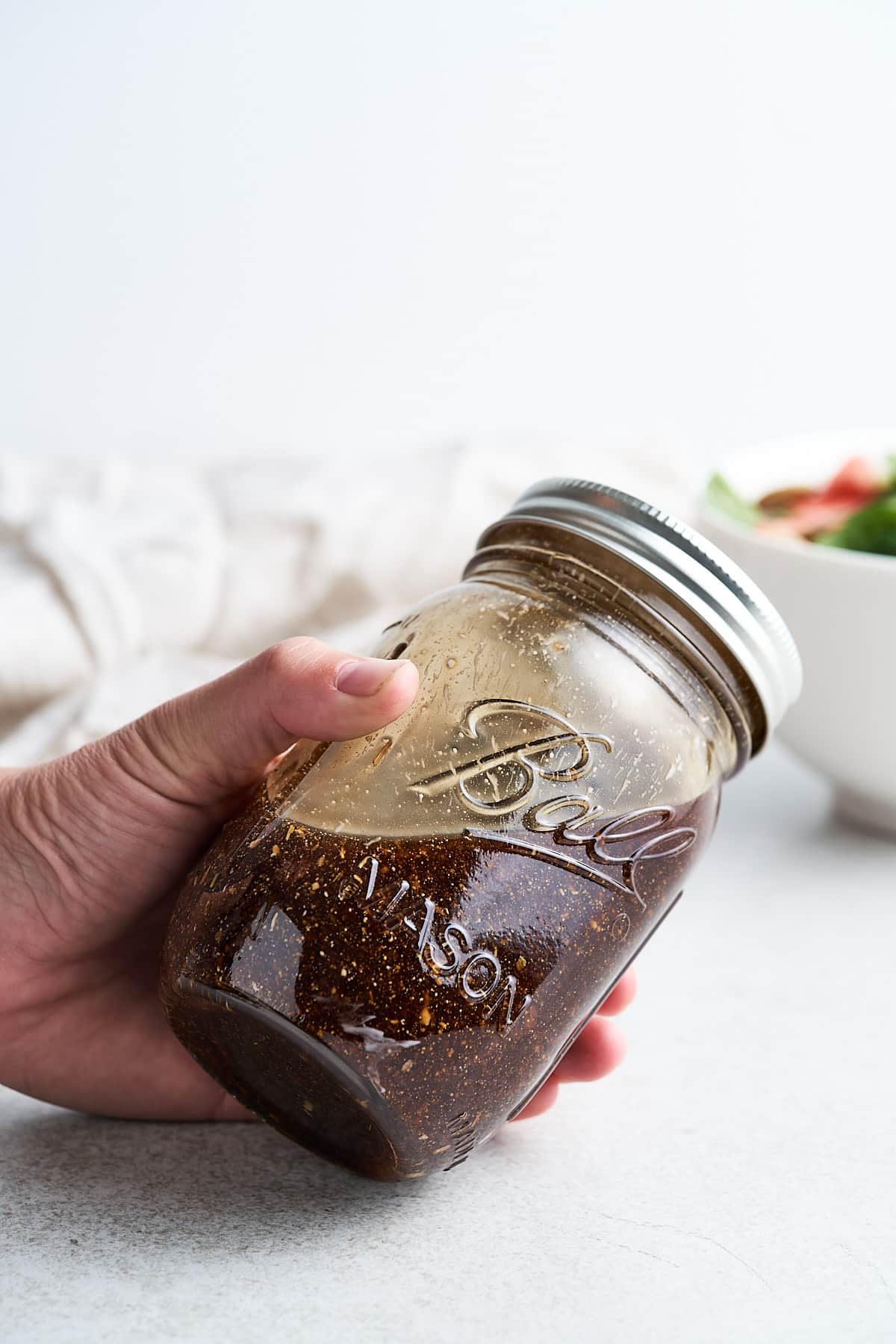Oil and vinegar dressing is a classic flavor enhancer found in recipes like salads, roasted vegetables, and marinades. Once you master the basics, customize your vinaigrette with different vinegars, oils, emulsifiers, and seasonings to suit your liking. It’s time to up your salad game!
If you mix olive oil and balsamic vinegar you’ll create a basic vinaigrette, but eventually they’ll separate, with the oil floating to the top. If you add a good dollop of Dijon mustard to the vinegar, then whisk in the oil, the mustard will act as an emulsifier and hold the two together much longer.

How to make an oil and vinegar dressing
Once you’ve determined which acid, vinegar, emulsifier, and flavorings you’ll be using, you need to mix them into one deliciously smooth sauce! As you’re probably well aware, oil and vinegar do not like to stay together. You have a few options for emulsifying the dressing, each with its pros and cons:
- Option 1 – Whisk: Easiest option, but separates the quickest.
- Option 2 – Jar: Also easy if you have a mason jar. Again, it will separate fairly easily.
- Option 3 – Blender: Mixes the dressing the best, giving it a smooth and creamy texture. The dressing will eventually separate, but it lasts the longest.
The mixing method is up to you, but if I had to pick one, I’d go with the blender. There is a bit more clean up involved, but it’s completely worth your salad being evenly coated with each dressing component.

The sky is the limit when it comes to the combinations you can make with this basic vinaigrette formula! Here are a few of our favorites! We’ve listed the ingredients in order of: type of acid, type of oil, emulsifier, flavor add-ins
- Balsamic Vinaigrette: balsamic vinegar, extra virgin olive oil, dijon mustard, minced garlic
- Red Wine Vinaigrette: red wine vinegar, extra virgin olive oil, dijon mustard, minced shallot
- Sesame Ginger Vinaigrette: rice vinegar, sesame oil, tahini, minced ginger
- Lemon Vinaigrette: lemon juice, extra virgin olive oil, mustard, fresh thyme
Keep your oil and vinegar dressing in a mason jar or an airtight container with a lid. Follow these general guidelines, depending on the type of vinaigrette you’ve made:
- Room temperature: If your dressing only has oil and vinegar in it, you can store it at room temperature for a few weeks.
- Fridge: If your vinaigrette contains ingredients like egg yolks, mayonnaise, or fresh citrus, keep it in the fridge for up to a week.
Oil and vinegar dressing basics
It couldn’t be more straightforward to create the perfect vinaigrette. Use this basic formula as a guideline, then branch out from there:
- Three or four parts oil (olive oil, avocado oil, etc.)
- One part acid (vinegar, citrus juice, etc.)
- A dash of emulsifier (mustard, honey, mayo, tahini, etc.)
If you want to end up with 1 cup of dressing, you will need to combine ¼ cup vinegar with ¾ cup oil. As I mentioned, this is just a starting point, but you get the drift! Always taste and adjust the oil and vinegar dressing to your liking.
How To Prepare Oil And Vinegar Dressing
FAQ
What is the best way to combine oil and vinegar?
How do you bind oil and vinegar?
What keeps oil and vinegar together?
How do you mix oil & vinegar?
These three methods blend the liquids together for only a few minutes before they separate again: Place the oil and vinegar in a jar with a tight-fitting lid and shake the jar vigorously for 30 seconds. Whisk the two liquids in a bowl with a wire whisk. Blend the oil and vinegar using an immersion or countertop blender or a food processor.
Do vinegar pills work the same way as vinegar?
There is evidence that vinegar can successfully reduce post-meal glucose levels in both normal subjects and those with type 2 diabetes. However, research indicates that vinegar pills produce a different effect than liquid vinegar. It’s not as helpful as liquid vinegar in lowering the post-meal glucose spike in young and healthy adults (PMID: 33489366).
How to pair oil & vinegar?
There are no strict rules on how to pair oils and vinegars, but the general principle here is just like in food pairing – try to think of some well known food combinations: honey and lemon, chocolate and oranges, walnuts and apples, chilly and pineapple and so on. Many resources are available online with extensive lists of oil and vinegar pairings.
Can You Mix Olive oil and vinegar?
Few could argue that oil and vinegar is a perfect match. The combination is widely used for salads, for dipping bread or for marinades. Usually it’s just a regular balsamic vinegar and olive oil. But have you ever tried searching for something more interesting, such as walnut oil or raspberry vinegar, and then combining the two?
